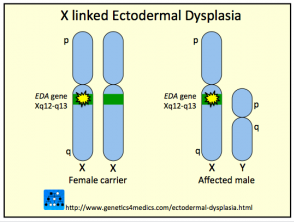What is it ectodermal dysplasia?
Ectodermal dysplasia is a large group of inherited disorders characterized by a primary defect in hairteeth nail or function of the sweat glands, in addition to another abnormality in any tissue of ectodermal origin. These are ears, eyes, lips, mucous membranes of the mouth or nose, and the central nervous system.
The ectoderm is the outermost layer of cells in embryonic development and contributes to the formation of many parts of the body, including all of those described above. Ectodermal dysplasia occurs when the ectoderm of certain areas does not develop normally. All ectodermal dysplasias are present from birth and are notprogressive.
Classification of ectodermal dysplasia
Currently, there are about 150 different types of ectodermal dysplasias. In an attempt to classify them, different subgroups are created according to the presence or absence of the four defects of primary ectodermal dysplasia (ED):
- ED1: Trichodysplasia (capillary dysplasia)
- ED2: dental dysplasia
- ED3: Onychodysplasia (nail dysplasia)
- ED4: Dyshidrosis (dysplasia of sweat glands)
Based on the above, the 150 different types of ectodermal dysplasias are classified into one of the following subgroups formed by the primary ED defects:
- Subgroup 1-2-3-4
- Subgroup 1-2-3
- Subgroup 1-2-4
- Subgroup 1-2
- Subgroup 1-3
- Subgroup 1-4
- Subgroup 2-3-4
- Subgroup 2-3
- Subgroup 2-4
- Subgroup 3
- Subgroup 4
The most common ectodermal dysplasias are hypohydrotic (anhydrotic) ED belonging to subgroup 1-2-3-4 and hydrotic ED belonging to subgroup 1-2-3.
The three most recognized ectodermal dysplasia syndromes fall in subgroup 1-2-3-4, as they show characteristics of the four primary ED defects. They are:
- Electrodactyly-ED-cleft syndrome
- Rapp-Hodgkin Hypohydrotic ED
- Ankyloblepharon, ectodermal defects, cleft lip / palate (AEC) or Hay-Wells syndrome
Prenatal Tests are available for ectodermal dysplasia syndromes at some centers.
What is the cause of ectodermal dysplasia?
The different types of ectodermal dysplasia are caused by mutation or removal of certain genes located in different chromosomes. Because ectodermal dysplasias are caused by a genetic default, they can be inherited or transmitted by the family line. In some cases, they can occur in people with no family history of the condition, in which case a de novo The mutation has occurred.
Genetics of Ectodermal Dysplasia *

Ectodermal dysplasia
* Image courtesy of Genetics 4 Medics
What are the signs and symptoms of ectodermal dysplasia?
The signs and symptoms of ectodermal dysplasia differ markedly between different types and depend on the structures affected. Signs and symptoms are generally not apparent in newborns and cannot be detected until infancy or childhood.
Anhydrotic ectodermal dysplasia

Anhydrotic ectodermal dysplasia
Ectodermal dysplasia generally affects the four organs involved primarily in the following ways:
| Organ affected | Characteristics |
|---|---|
| Hair |
|
| Nail |
|
| Teeth |
|
| Sweat glands |
|
Other signs and symptoms include:
- Slightly pigmented skin, in some cases red or brown pigment may be present. The skin may be thick on the palms and soles and is prone to cracking, bleeding, and infection.
- The skin may be dry and prone to rashes and infections.
- Dry eyes occur due to lack of tears. waterfalls and visual defects can also occur.
- Abnormal ear development can cause hearing problems.
- Cleft palate / lip.
- Lack of fingers and toes (digits)
- Respiratory infections due to a lack of normal protective secretions from the mouth and nose.
- Smelly Nasal download since chronic nasal infections
- Lack of breast development.
What is the treatment for ectodermal dysplasia?
There is no specific treatment for ectodermal dysplasia. Managing the condition is by treating the various symptoms. Patients often need to be treated by a team of doctors and dentists, rather than a single professional.
- Patients with no or no sweat gland function should live in colder climates or in air-conditioned places at home, school, and work. Cold water baths or sprays can be helpful in maintaining normal body temperature.
- Artificial tears can be used to prevent damage to the cornea in patients with defective production of tears. Saline Aerosols can also be helpful.
- Saline irrigation of the nose mucous membrane can help eliminate purulent Debris and prevent infection.
- Early dental evaluation and intervention are essential.
- Surgical procedures such as repairing a cleft palate can decrease facial deformities and improve speech.
- Wigs can be used to improve the appearance of patients with little or no hair.
Most people with ectodermal dysplasia can lead full and productive lives once they understand how to manage their condition. Special attention should be paid to children if they sweat and bugger There are abnormalities in production. Recurrent high fevers can cause seizures and neurological problems.
